Sample Tenancy Termination Letters
-
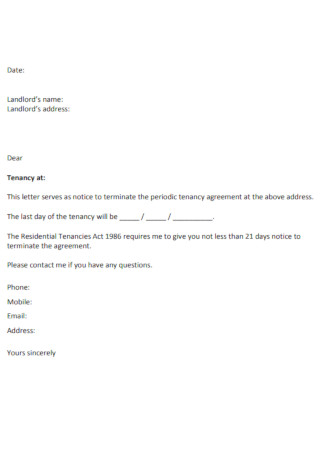
Sample Tenancy Termination Letter
download now -
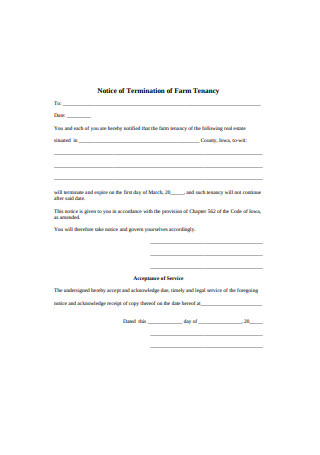
Notice-of-Termination Letter of Farm Tenancy
download now -
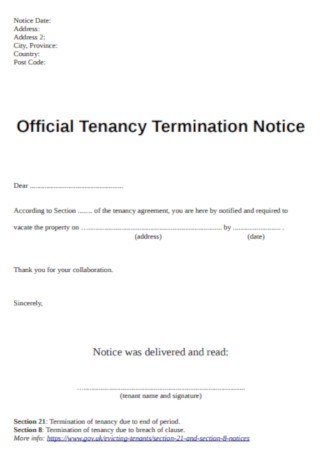
Official Tenancy Termination Notice Letter
download now -
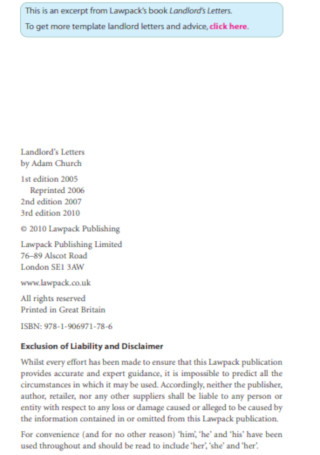
Sample Landlord’s Termination Letters
download now -

Formal Tenancy Termination Letter
download now -
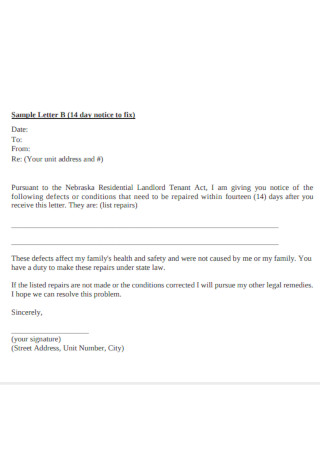
Residential Landlord Tenancy Termination Letter
download now -
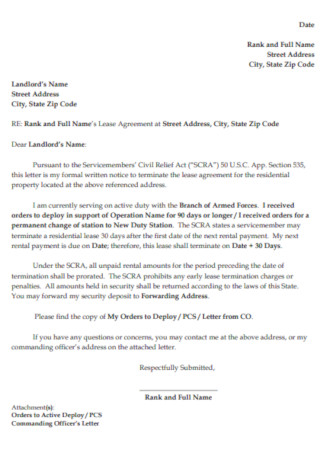
Residential Lease Termination Letter Template
download now -
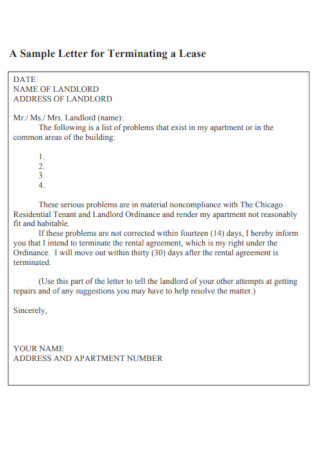
Sample Letter for Terminating a Lease
download now -
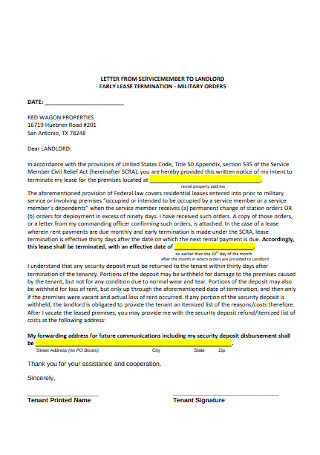
Landlord Early Lease Termination Letter
download now -
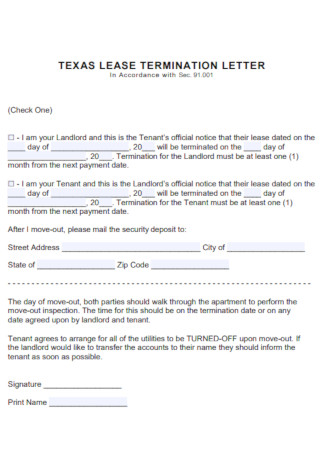
Basic Lease Termination Letter
download now -
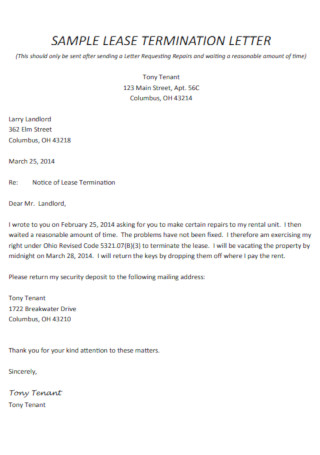
Sample Tenant Lease Termination Letter
download now -
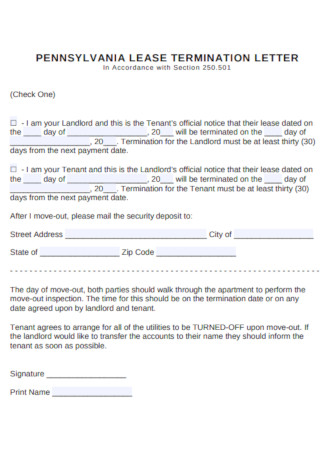
Standard Lease Termination Letter
download now -
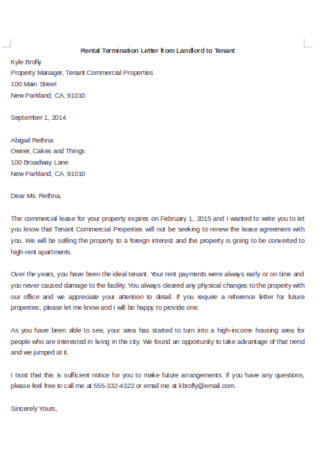
Rental Termination Letter From Landlord to Tenant
download now
FREE Tenancy Termination Letter s to Download
Sample Tenancy Termination Letters
What Is a Termination Letter?
Benefits of Termination Letter
Qualities of a Good Tenant
How to Write a Termination Letter
FAQs
What is the reason for termination?
What is the purpose of termination of employment?
Is a termination permanent?
What Is a Termination Letter?
A termination letter from an employer to a worker contains relevant information about the employee’s termination. Typically, it serves as a formal notice to the employee and an official termination record. Termination letters are also known as letters of termination, letters of dismissal, and termination notices. Although less common today, the term “pink slip” may refer to a termination letter delivered on the pink layer of a triplicate form. While no legal requirement exists to create or provide a termination letter, a comprehensive and detailed letter can prevent a former employee from claiming they were fired without cause or knowledge. Suppose a termination letter includes the reasons for an employee’s dismissal. In that case, it can also be used as proof that the employee was terminated for a valid reason, although it is not a defense against a wrongful termination lawsuit.
Benefits of Termination Letter
Important termination letters facilitate straightforward communication between employers and employees. Employers use termination letters to inform employees of their dismissal in all other situations. You can hand-deliver a termination letter or transmit it to the individual’s last known address. Once the employee receives the letter, their notice period officially commences. The primary advantages of using termination letters to notify dismissal are as follows:
Qualities of a Good Tenant
Tenants are considered the ‘blood’ of any rental property checklist business. It is the only reason why the company is operational and successful. We mean “quality tenants” who pay their rent on time and treat the property as their own. Tenants of high caliber are extremely valuable, but they can be difficult or elusive to locate at times. Indeed, a rental property enterprise is an excellent passive income source. A constant influx of tenants implies a continuous cash flow statement for the landlord of an investment property. If you want to draw tenants to your property but are still trying to figure out how to do so, have no fear! We’ve outlined the steps for selecting prospective tenants and the characteristics you should search for!
1. Prepare the Criteria
Before abandoning a decision, there will always be a set of criteria that will be considered for every decision we make. The same holds when selecting a tenant for your rental property. We want to defend our property, but not to the point of discouraging potential tenants. Consider yourself one of the judges at a prestigious beauty contest and your prospective tenants to be the contestants. How do you select the worthy recipient of the crown?
2. Advertise in the Appropriate Locations
Now that you better understand your prospective tenants’ qualities, it is time to list your rental property. Although flyers and posters may still be helpful, posting your advertisement online will save you more time and effort. In this age of technology, almost everything can be discovered online, including your next tenant. Now, avoid posting your rental ad in random online locations. You will position your ad on market-related websites and social media platforms to attract more renters. If you place your advertisement in the wrong areas, you may attract undesirable tenants who could harm your business and finances. Facebook, Google, and LinkedIn are among the websites offering customized advertisements for a more refined result. Be specific with the details you include in your advertising brochures. In addition to the rental price, provide additional information such as the location, lot and floor size, number of bedrooms and bathrooms, and whether or not there is a garage. Remember to include attractive features and amenities that will help you attract excellent and dependable tenants. Include the advantages of relocating into your home. If you require a rental application, you may also specify the required documents, such as a credit report. Educate prospective tenants on the application procedure.
3. Conduct a Complete Tenant Screening Procedure
You place an online ad, and someone eventually calls you back after waiting. However, he must be thoroughly examined before allowing a stranger to occupy your property. Here is where your prepared criteria are helpful. An excellent tenant should possess most, if not all, of the qualities you listed as requirements. And tenant vetting is the ideal way to accomplish this. In addition to the predetermined criteria, you can also inquire whether he has sufficient income to pay the rent for the duration of the lease. Does he clear your background investigation? Does he have any prior reports of property damage? Has he previously violated a room rental agreement in violation of the law? Most importantly, examine the rental history of your prospective tenant to determine if he has a strong track record of timely bill payments. Requesting a tenant’s credit report is also beneficial. Determine their debt-to-income ratio. Ensure your tenant has an impeccable credit history and no outstanding credit balances.
4. Avoid Discrimination
The essential principle. Accept applicants solely based on race, color, sex, religion, or physical disability. Your reputation as a landlord may improve if you are appropriately demanding for the right reasons. Remember that in the rental property business, you will naturally encounter a wide variety of people, and you should treat each one with dignity. If your prospective tenant satisfies all of your requirements, is there any reason you shouldn’t let him in?
5. Contact Former Landlords
You must contact his previous landlords as part of your tenant vetting process. Please verify that your application has previously rented to them, made timely rent payments, established a positive landlord-tenant relationship with them, is not a disruptive neighbor, and left the rental property in good condition. This will give you a concept of how your prospective tenant will treat and care for your property. In addition to contacting their previous landlords, you can verify their income by calling their current employer. The best method to verify a person’s income is to speak with their employers to obtain firsthand information.
How to Write a Termination Letter
A decent resignation letter must address the employee’s concerns and seek to end the employment relationship amicably. The employee must be given a reasonable quantity of time and compensation to deal with the situation following unemployment. Thus, issuing a one may also be viewed as a generous and respectful method to terminate an employee without discrimination. If you are still intrigued, here are the steps involved in writing a proper letter of termination:
1. Start with the Date
Since you may be writing the letter on company letterhead, the company’s name and address must be at the top. Therefore, you can commence with the date the letter was written. Below the printed heading, the date can be reported to the right or left of the printed header. Additionally, use a salutation such as ‘Dear’ to address the employee. Include the employee’s full name in the salutation when handling the employee.
2. Make a Formal Declaration of Separation
Declare unequivocally that the company has terminated the employee’s services. You can commence with phrases such as ‘I regret to inform you that…’, ‘This letter serves as official notification that…’, or ‘Please take note that…’. You must specify the date the termination will take effect. This would be the final day of employment for the employee. The period between the date of assistance of the termination notice and the ultimate date of termination must equal or exceed the notice period specified in the employment contract.
3. Include the Grounds for the Dismissal
Mention all the causes for the employee’s termination. Explain the company’s position explicitly in the event of dismissal without cause. If the stop is for cause, the reasons should be supported by evidence whenever possible. The letter must specify that the employee was given ample opportunity to take corrective action before the company decided to proceed with the termination.
4. Describe the Terms of the Settlement
Describe the potential compensation and benefits to which the employee may be entitled. These may include provident fund, pension, leave encashment, and separation pay. Inform them how to retrieve their concluding documents, such as experience certificates and pay stubs. Specify whether their coverage under the employee insurance policy will expire or continue until a specific date if they are covered. Also, request their return if the employee has company property, such as godown keys, a laptop, a cell phone, or an identification card. You may grant them a reasonable time to vacate if they reside in company-provided housing.
5. Remind Them of the Legal Obligations
Certain agreements, such as non-disclosure and non-compete clauses, remain in effect even after an employee leaves the company. Ensure that you remind them of these valid agreements. Additionally, you may include a copy of such arrangements for their records. After the letter, you can have the contact information of the HR representative to whom the employee can direct questions. Include each person along with the HR function(s) they perform if multiple individuals perform distinct HR functions.
6. Maintain a Businesslike Tone
Use a formal tone and language throughout the entire letter, regardless of your relationship with the employee. Keep the content pertinent, concise, and straightforward. Be truthful and precise when representing the events. You can conclude the letter with well wishes or sympathy for the employee’s situation. The closing salutation may include “Sincerely” or “Best Regards.” Leave space for a signature, then sign your name below. After printing the letter, be sure to endorse it.
FAQs
What is the reason for termination?
Incompetence, such as a shortage of productivity or poor work quality. Insubordination and related issues, including dishonesty or violation of company policies. Problems with attendance, including frequent absences and recurrent tardiness. Theft or other illicit conduct, including the disclosure of trade secrets.
What is the purpose of termination of employment?
Employees may be terminated by their own volition or by the employer’s decision. Employers may terminate employees for various reasons, such as reduction, poor job evaluation reports, or redundancies.
Is a termination permanent?
There is a distinction between suspension and dismissal. An employee is laid off when an employer temporarily ceases operations. In contrast, termination occurs when the employer ceases working permanently.
Occasionally, a notice to vacate is required to terminate a lease early or have a tenant on a tentative month-to-month agreement move out. Knowing how to compose the information properly will prevent misunderstandings or the need to initiate eviction proceedings. Fortunately, the letter is straightforward enough if you adhere to the provided template.
